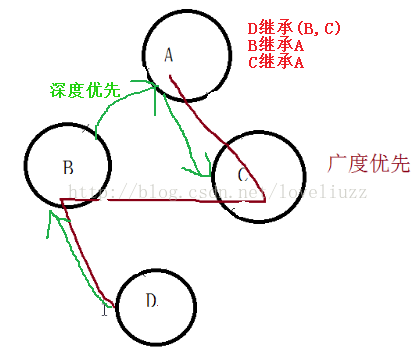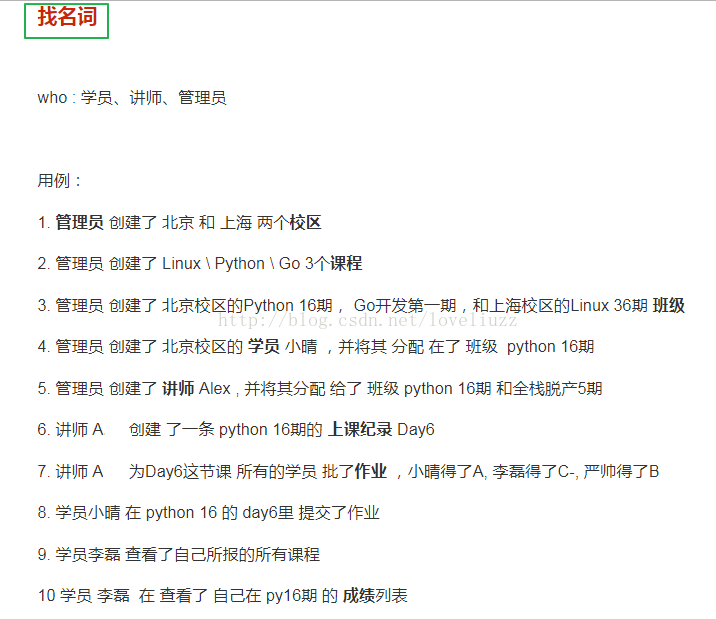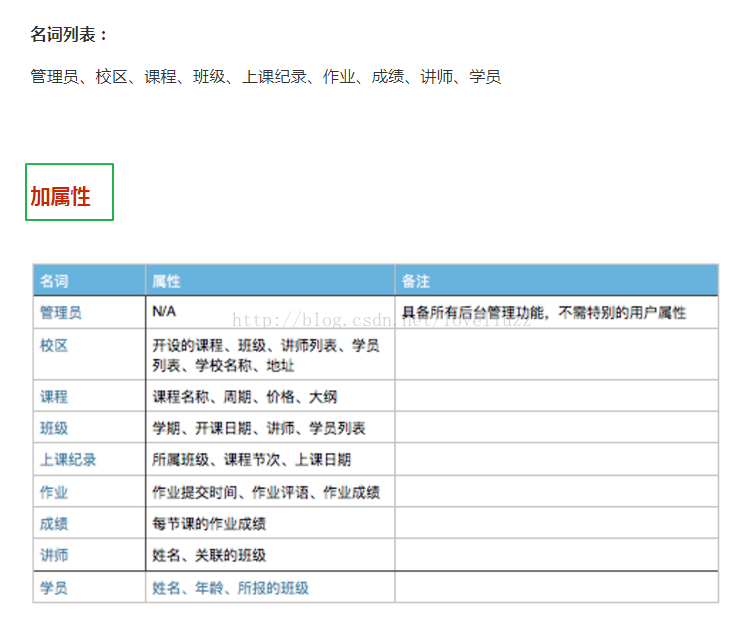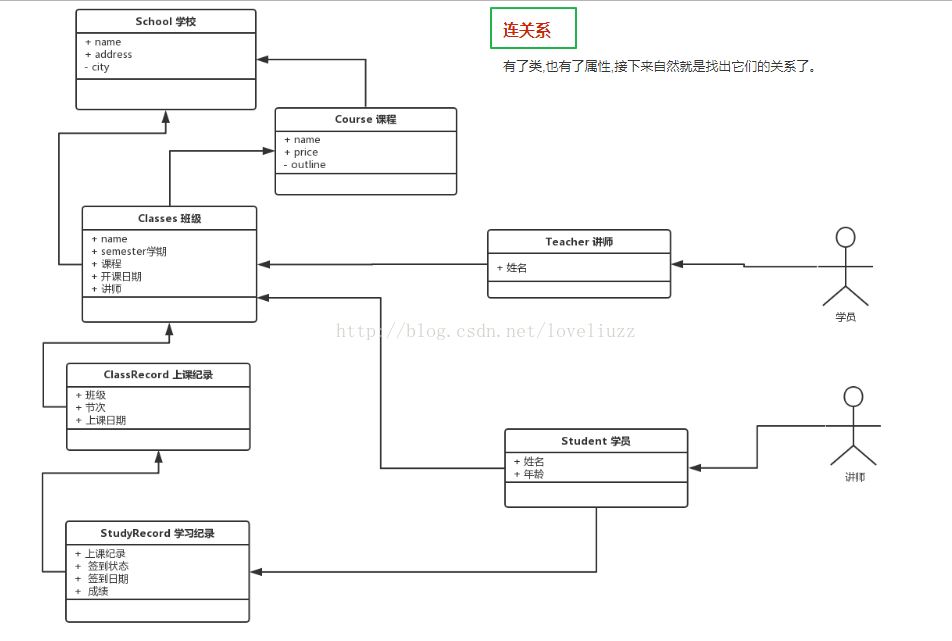本文实例讲述了python3.5面向对象程序设计之类的继承和多态。分享给大家供大家参考,具体如下:
1、继承的定义
继承是指:可以使用现有类的所有功能,并在无需重新编写原来的类的情况下对这些功能进行扩展。
(1)通过继承创建的新类称为“子类”或“派生类”。
(2)被继承的类称为“基类”、“父类”或“超类”。
继承的过程,就是从一般到特殊的过程。要实现继承,可以通过“继承”(inheritance)和“组合”(composition)来实现。
在某些 oop 语言中,一个子类可以继承多个基类。但是一般情况下,一个子类只能有一个基类,要实现多重继承,可以通过多级继承来实现。
2、继承的分类
继承概念的实现方式主要有2类:实现继承、接口继承。
(1) 实现继承是指使用基类的属性和方法而无需额外编码的能力;
(2)接口继承是指仅使用属性和方法的名称、但是子类必须提供实现的能力(子类重构父类方法);
在考虑使用继承时,有一点需要注意,那就是两个类之间的关系应该是“属于”关系。
抽象类仅定义将由子类创建的一般属性和方法。
oo开发范式大致为:划分对象→抽象类→将类组织成为层次化结构(继承和合成) →用类与实例进行设计和实现几个阶段。
3、示例代码
|
1
2
3
4
5
6
7
8
9
10
11
12
13
14
15
16
17
18
19
20
21
22
23
24
25
26
27
28
29
30
31
32
33
34
35
36
37
38
39
|
#!/usr/bin/env python# -*- coding:utf-8 -*-# author:zhengzhengliu#类的继承class people: def __init__(self,name,age): self.name = name self.age = age def eat(self): print("%s is eating..." %self.name) def sleep(self): print("%s is sleeping..." %self.name) def talk(self): print("%s is talking..." %self.name)class man(people): #继承父类people类 def make_money(self): print("%s is making money..." %self.name) def sleep(self): people.sleep(self) #对父类方法的扩展 print("man is sleeping...")class women(people): def shop(self): print("%s is shopping..." %self.name)m1 = man("jack","20")m1.eat()m1.make_money()m1.sleep()w1 = women("amy","25")w1.talk()w1.shop() |
运行结果:
jack is eating...
jack is making money...
jack is sleeping...
man is sleeping...
amy is talking...
amy is shopping...
4、子类中对父类的构造函数进行重构两种方法
|
1
2
3
4
5
6
7
8
9
10
11
12
13
14
15
16
17
18
19
20
21
22
23
24
25
26
27
28
29
30
31
32
33
34
35
36
37
38
39
40
41
42
43
44
45
46
|
#!/usr/bin/env python# -*- coding:utf-8 -*-# author:zhengzhengliu#类的继承#class people: #经典类class people(object): #新式类 def __init__(self,name,age): self.name = name self.age = age def eat(self): print("%s is eating..." %self.name) def sleep(self): print("%s is sleeping..." %self.name) def talk(self): print("%s is talking..." %self.name)class man(people): #继承父类people类 def __init__(self,name,age,money): #people.__init__(self,name,age) #(方法一)对构造函数进行重构、添加父类中没有的属性 super(man,self).__init__(name,age) #(方法二)利用super对构造函数进行重构(新式类写法) self.money = money print("%s have money %s$" %(self.name,self.money)) def make_money(self): print("%s is making money..." %self.name) def sleep(self): people.sleep(self) #对父类方法的扩展 print("man is sleeping...")class women(people): def shop(self): print("%s is shopping..." %self.name)m1 = man("jack","20",10)m1.eat()m1.make_money()m1.sleep()w1 = women("amy","25")w1.talk()w1.shop() |
运行结果:
j ack have money 10$
jack is eating...
jack is making money...
jack is sleeping...
man is sleeping...
amy is talking...
amy is shopping...
5、多继承方式
|
1
2
3
4
5
6
7
8
9
10
11
12
13
14
15
16
17
18
19
20
21
22
23
24
25
26
27
28
29
30
31
32
33
34
35
36
37
38
39
40
41
42
43
44
45
46
47
48
49
50
51
|
#!/usr/bin/env python# -*- coding:utf-8 -*-# author:zhengzhengliu#类的继承#class people: #经典类class people(object): #新式类 def __init__(self,name,age): self.name = name self.age = age self.friends = [] def eat(self): print("%s is eating..." %self.name) def sleep(self): print("%s is sleeping..." %self.name) def talk(self): print("%s is talking..." %self.name)class relationship(object): def make_friends(self,obj): print("%s is making friends with %s" %(self.name,obj.name)) self.friends.append(obj)class man(people,relationship): #多继承 def __init__(self,name,age,money): #people.__init__(self,name,age) #(方法一)对构造函数进行重构、添加父类中没有的属性 super(man,self).__init__(name,age) #(方法二)利用super对构造函数进行重构(新式类写法) self.money = money print("%s have money %s$" %(self.name,self.money)) def make_money(self): print("%s is making money..." %self.name) def sleep(self): people.sleep(self) #对父类方法的扩展 print("man is sleeping...")class women(people,relationship): #多继承 def shop(self): print("%s is shopping..." %self.name)m1 = man("jack","20",10)w1 = women("amy","25")m1.make_friends(w1)w1.name = "liu"print(m1.friends) |
运行结果:
jack have money 10$
jack is making friends with amy
[<__main__.women object at 0x0057fa30>]
6、新式类与经典类的继承顺序
|
1
2
3
4
5
6
7
8
9
10
11
12
13
14
15
16
17
18
19
20
21
22
23
|
#!/usr/bin/env python# -*- coding:utf-8 -*-# author:zhengzhengliuclass a(object): #新式类 def __init__(self): print("a")class b(a): def __init__(self): print("b")class c(a): def __init__(self): print("c")class d(b,c): def __init__(self): pass #print("d")obj = d() |


7、继承示例——学校、教师与学生
|
1
2
3
4
5
6
7
8
9
10
11
12
13
14
15
16
17
18
19
20
21
22
23
24
25
26
27
28
29
30
31
32
33
34
35
36
37
38
39
40
41
42
43
44
45
46
47
48
49
50
51
52
53
54
55
56
57
58
59
60
61
62
63
64
65
66
67
68
69
70
71
72
73
74
75
76
77
78
79
80
81
82
83
84
85
86
87
88
89
90
91
92
|
#!/usr/bin/env python# -*- coding:utf-8 -*-# author:zhengzhengliu#继承实例(新式类)——模拟学校、教师与学生class school(object): def __init__(self,name,addr): self.name = name self.addr = addr self.students = [] self.stuffs = [] def enroll(self,stu_obj): #学生注册 print("%s 学员办理注册" %stu_obj.name) self.students.append(stu_obj) def heir(self,staff_obj): #聘请教师 print("聘请教师 %s" %staff_obj.name) self.stuffs.append(staff_obj)class schoolmember(object): def __init__(self,name,age,sex): self.name = name self.age = age self.sex = sex def tell(self): passclass teacher(schoolmember): def __init__(self,name,age,sex,salary,course): super(teacher,self).__init__(name,age,sex) self.salary = salary self.course = course def tell(self): print(''' ----- info of teacher:%s ----- name:%s age:%s sex:%s salary:%s course:%s '''%(self.name,self.name,self.age,self.sex,self.salary,self.course)) def teach(self): print("%s is teaching course [%s]" %(self.name,self.course))class student(schoolmember): def __init__(self,name,age,sex,stu_id,grade): super(student,self).__init__(name,age,sex) self.stu_id = stu_id self.grade = grade def tell(self): print(''' ----- info of student:%s ----- name:%s age:%s sex:%s stu_id:%s grade:%s '''%(self.name,self.name,self.age,self.sex,self.stu_id,self.grade)) def pay_tuition(self,amount): print("%s has paied tuition for $%s" %(self.name,amount))#实例化school = school("qinghua","beijing")t1 = teacher("jack","30","m","20000","python")t2 = teacher("amy","28","f","15000","linux")s1 = student("liu","23","m","1701","python")s2 = student("wang","25","f","1702","linux")#调用显示学生与教师的信息t1.tell()s1.tell()school.heir(t1) #聘请教师t1school.enroll(s1) #学生s1注册school.enroll(s2)print(school.stuffs)print(school.students)#聘请的第一位教师教课school.stuffs[0].teach()for stu in school.students: stu.pay_tuition(5000) |
运行结果:
----- info of teacher:jack -----
name:jack
age:30
sex:m
salary:20000
course:python
----- info of student:liu -----
name:liu
age:23
sex:m
stu_id:1701
grade:python
聘请教师 jack
liu 学员办理注册
wang 学员办理注册
[<__main__.teacher object at 0x0059fdb0>]
[<__main__.student object at 0x0059fdf0>, <__main__.student object at 0x0059fe10>]
jack is teaching course [python]
liu has paied tuition for $5000
wang has paied tuition for $5000
8、多态(polymorphisn)——一种接口,多种形态
(1)定义
多态性(polymorphisn)是允许你将父对象设置成为和一个或更多的他的子对象相等的技术,
赋值之后,父对象就可以根据当前赋值给它的子对象的特性以不同的方式运作。
简单的说,就是一句话:允许将子类类型的指针赋值给父类类型的指针。
多态的作用:我们知道,封装可以隐藏实现细节,使得代码模块化;继承可以扩展已存在的代码模块(类);它们的目的都是为了——代码重用。
而多态则是为了实现另一个目的——接口重用!多态的作用,就是为了类在继承和派生的时候,保证使用“家谱”中任一类的实例的某一属性时的正确调用。
pyhon 很多语法都是支持多态的,比如 len(),sorted(), 你给len传字符串就返回字符串的长度,传列表就返回列表长度。
(2)示例代码:
|
1
2
3
4
5
6
7
8
9
10
11
12
13
14
15
16
17
18
19
20
21
22
23
24
25
26
27
28
29
30
31
32
33
|
#!/usr/bin/env python# -*- coding:utf-8 -*-# author:zhengzhengliuclass animal(object): def __init__(self,name): self.name = name def talk(self): raise notimplementederror("subclass must implement abstract method") # 多态——一种接口,多种形态 @staticmethod def animal_talk(obj): obj.talk()class cat(animal): def talk(self): print("%s meow!" %self.name)class dog(animal): def talk(self): print("%s woof! woof!" % self.name)d = dog("a")#d.talk()c = cat("b")#c.talk()#多态animal.animal_talk(d)animal.animal_talk(c) |
运行结果:
a woof! woof!
b meow!
9、面向对象设计利器——领域建模
(1)定义
从领域模型开始,我们就开始了面向对象的分析和设计过程,可以说,领域模型是完成从需求分析到面向 对象设计的一座桥梁。
领域模型,顾名思义,就是需求所涉及的领域的一个建模,更通俗的讲法是业务模型。
(2)领域模型有两个主要的作用:
发掘重要的业务领域概念
建立业务领域概念之间的关系
(3)领域建模三字经
领域模型如此重要,领域建模的方法概括一下就是“找名词”! 即使是简单的找名词这样的操作,也涉及到分析和提炼,而 不是简单的摘取出来就可,
这种情况下分析师和设计师的经验和技能就能够派上用场了。但领域模型分析 也确实相对简单,即使没有丰富的经验和高超的技巧,至少也能完成一个能用的领域模型。
一个关键的问题:从哪里找? 因为领域模型是“需求到面向对象的桥梁”,能想到:从需求模型中找,具体来说就是从用例中找。
归纳:领域建模的方法就是“从用例中找名词”。 当然,找到名词后,为了能够更加符合面向对象的要求和特点。
我们还需要对这些名词进一步完善,这就 是接下来的步骤:加属性,连关系!
最后我们总结出领域建模的三字经方法:找名词、加属性、连关系。



希望本文所述对大家python程序设计有所帮助。
原文链接:https://blog.csdn.net/loveliuzz/article/details/78196840










